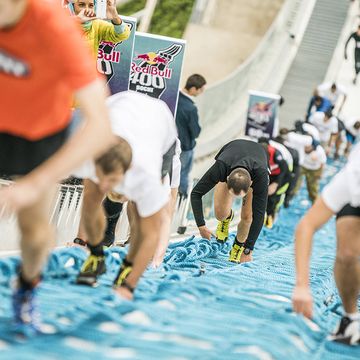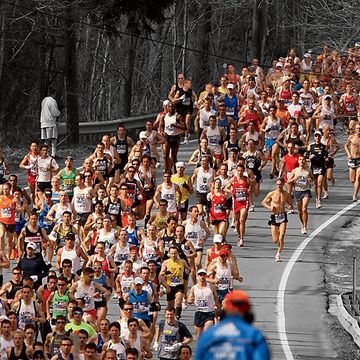It's the worst-kept secret in running: If you want to improve strength and speed, run hills.
Recently, I did a trail run in Seattle with Tony Young, the world record-holder in the mile for men age 45–49 (4:16.09). Tony stopped at a point where the trail split, and he pointed up one fork, a 300m woodchip incline.
"See this hill?" said Tony. "If I beat you for the masters cross country title in December, this hill will be the reason why."
Tony's faith in the power of hills has precedent. In the 1960s, New Zealand coach Arthur Lydiard used hill training to propel his country's distance runners to international acclaim. Sebastian Coe relied on hills for the strength that netted him 11 indoor and outdoor world records in the late '70s and early '80s. And the slopes of the Great Rift Valley have lifted Kenyans to domination of the world distance scene for decades.
So why don't more runners make hills a centerpiece of their training?
Simply put, most runners don't understand how to train on hills. We pick hills that are too long or too steep. We run them too fast. We allow too little time afterward to recover. The result is a poor training effect at best, injury and burnout at worst.
Before we charge willy-nilly up the nearest mountain trail, we need to understand the training adaptations we're after and the best way to achieve them.
Hill training, demystified?
A weight lifter looking to improve his maximum bench press doesn't add lighter-weight reps to his workout. He doesn't do his reps more quickly. Instead, he increases the weight on the bar, thereby increasing the force required to complete his reps.
It's the same with running. If we want to get stronger and faster, we must increase the force requirements of our workout. Tempo runs, time trials and fast reps on the track are good, but they don't generate maximum force. Hills do.
"Running up hills forces the knees to lift higher, one of the most desirable developments for any runner, because this governs stride speed and length," wrote Lydiard (with Garth Gilmour) in his book Running With Lydiard. "It also develops the muscle fibers, increasing power."
In fact, we can target all three types of muscle fiber (a "fiber" is what we call a muscle cell) with hill training: slow-twitch (Type I), intermediate fast-twitch (Type IIa) and fast-twitch (Type IIx). Slow-twitch produces the least force of the fiber types, but it works aerobically and takes a long time to fatigue, making it perfect for endurance activities. Intermediate fibers produce more force than slow-twitch, creating the long, powerful strides associated with middle-distance running. Fast-twitch fibers produce the most force of all, but they function anaerobically and are useful only for short bursts.
What Is Anaerobic Exercise?
When I attended La Canada High School in the 1970s, we had one of the best middle-distance programs in Southern California. One year, our school of 1,500 students boasted nine runners who could break 2:00 for the 880. Our secret? Coach Pat Logan employed a regimen of long hill runs for endurance, long hill reps for strength and short hill reps for speed.
When we run, we recruit our muscle fibers in a "ladder." We use slow-twitch fiber first, add intermediate fiber as the required force increases, and recruit fast-twitch fiber when our force requirement is greatest (e.g., sprinting up a steep hill).
Once we know how the ladder works, we can design hill workouts that target each type of muscle fiber and train those fiber types to work together more effectively.
FIVE HILL WORKOUTS
Before we outline the workouts, a word to the wise: Hill training significantly increases the force requirements of our workouts, so it demands an equal increase in our post-workout recovery. Never do more than one or two hill sessions per week, and always conduct the workouts at the recommended volume and intensity.
#1: Long Hill Runs
The long run is a staple of every distance runner's training arsenal. That's because our slow-twitch fibers require lower-intensity, longer-duration workloads to achieve maximum endurance. Adding a long hill (or hills) to this run results in several benefits:
- Exercises to Make You Stronger on Hills
- Reduces neural inhibition, improving coordination between muscle groups
- Increases ankle flexibility, improving our stride
- Reduces neural inhibition, improving coordination between muscle groups
- Sales & Deals
We begin by incorporating a half-mile to a mile of moderately steep uphill into our long run every second or third week. As our fitness improves, we can increase the total volume of uphill in our runs to 2–3 miles. The effort level for these runs should be comfortably aerobic. Running too hard won't give us a better workout. It will only decrease our volume of hill work, while increasing the time it takes to recover.
#2: The Right Way to Run Downhill
Two-time Olympic 1500m gold medalist Seb Coe maintained his off-season fitness by running circuits on a bicycle path that included an 800m hill section: 400m of steady uphill, 100m of level recovery, 250m of steep uphill and, finally, 50m of slight downhill.
"[Hill circuits are] an excellent means for improving both aerobic and anaerobic power," wrote Seb's father and coach, Peter Coe (with David Martin) in Better Training for Distance Runners. "Every serious distance runner should have one of these courses available for use when a hill session comes due on the schedule."
Long hill repeats force us to climb the muscle fiber ladder. The power required to run fast up a long hill (6 to 7 percent grade) recruits our intermediate fibers, as well as all available slow-twitch fibers. A typical weekly progression of long hill-repeat sessions might be:
4-8 × 30 Health - Injuries
4-8 × 60 seconds, 3-4 minutes rest
4-6 × 90 seconds, 4-5 minutes rest
As to pace, a simple rule of thumb is to finish every repetition workout with just enough gas in the tank to run one or two more repeats if the workout called for it.
#3: Give A Gift
NFL legend Walter Payton made short hill sprints synonymous with off-season football conditioning. But this workout also achieves two training objectives for distance runners:
- Strengthens all three types of muscle fiber
- Reduces neuromuscular inhibition
Sprinting up a steep hill at 90 to 95 percent maximum effort recruits the fullest range of fibers possible. It also demands the widest range of motion from our stride. To accomplish this motion, opposing muscle groups learn "reduced inhibition." Just as we relax the triceps muscle on the back of our arm when flexing our biceps, so our hamstrings and quadriceps must learn to coordinate contraction and relaxation. The result is a smoother, longer, faster stride.
Start with four or five reps of 30–60m (5–10 seconds) up a steep hill, then build up over a few sessions to eight to 12 reps. For recovery, walk back down the hill and wait until 2–3 minutes have passed.
#4: Hill Bounding
A great way to develop strength and stride efficiency is to incorporate "bounding" into our hill work. We use a moderate grade (6 to 7 percent) for this workout and perform one or more of the following variations of the bounding drill:
VERTICAL BOUNDING: Drive off the toes of the plant foot, lifting the opposite knee high, and emphasize vertical lift; land on the opposite foot and repeat.
HORIZONTAL BOUNDING: Same as vertical bounding, except that we emphasize the length (not height) of the bound.
SKIP BOUNDING: Same as vertical bounding, except that we land on the same foot that initiated the bound, then take a short step forward onto our opposite foot, spring vertically, land on that foot, and then repeat the whole process.
Whether springing high like Michael Jordan or far like Willie Banks, we bound for 50–70m, then jog back down the hill and repeat. One to two reps of each drill is sufficient.
#5: Downhill Strides
Our final "hill climb" isn't a climb at all. Downhill strides build quadriceps strength through eccentric contraction. An eccentric contraction occurs when a muscle simultaneously contracts (shortens) and relaxes (lengthens). When we run downhill, our quadriceps contracts to prevent our knees from buckling. At the same time, our knee does bend slightly, stretching our quadriceps. This tug-of-war results in two notable training effects:
- Eccentric contractions recruit fewer muscle fibers, increasing the force required from those that are activated.
- Reduces neural inhibition, improving coordination between muscle groups.
This reduced fiber recruitment coupled with more damage leads to a greater training adaptation: stronger quadriceps, better knee lift and a resistance to future quad soreness.
Start with four to five repeats of 60–100m on a moderately steep grade (6 to 7 percent). Run at 85 percent maximum pace and allow 2–3 minutes for recovery between reps. Build up to six to eight reps at 90 to 95 percent effort. If possible, do this workout on grass or the trails.
THE LAST WORD ON HILLS
When Tony Young pointed out his 300m wood-chip hill climb in Seattle, I failed to mention my own secret weapon: a 400m, 6 percent grade trail adjacent the nearby Rose Bowl, not to mention an equally perfect 3-mile road and trail climb into the neighboring San Gabriel Mountains. Like Tony, I can hardly wait to show off my hill-trained fitness at December's USATF Club Cross Country Championships.
There's a reason hill training is running's worst-kept secret: It works.














